Connectivity, habitat maintenance and support for native vegetation, native fish, frogs and other animals were the focus of releases for the Snowy montane rivers in 2023–24.
Key outcomes
Under wet to moderate conditions, environmental water managers worked with partner agencies and stakeholders to coordinate the delivery of water for the environment to:
- provide variable flows to the Snowy and upper Murrumbidgee rivers, with higher releases during winter and spring, typical of snowmelt rivers
- improve the condition of the Snowy River channel and provide suitable habitat for water-dependent animals such as macroinvertebrates and native fish
- provide habitat diversity and increase resource availability and productivity for water-dependent animals including macroinvertebrates, frogs, platypus, turtles and fish, as well as provide opportunities for breeding and recruitment
- inundate wetlands and ponds to provide breeding opportunities for several native frog species including the whistling tree frog (Litoria verreauxii)
- facilitate connectivity along multiple rivers including the Snowy, upper Murrumbidgee, Geehi and Goodradigbee rivers.
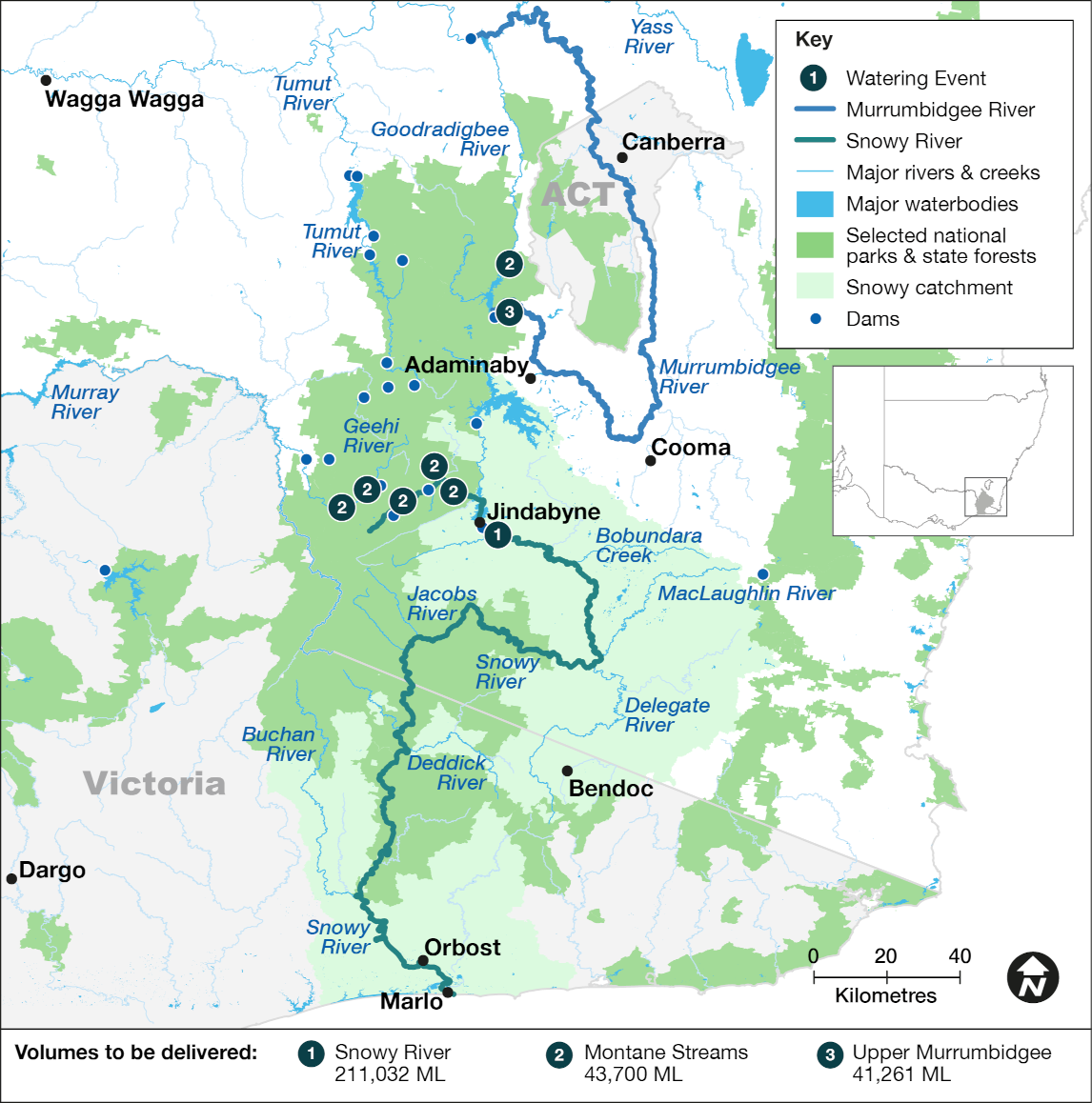
Map of the Snowy montane catchment showing locations of water for the environment deliveries made in the 2023-24 water year.
Catchment conditions
In 2023–24, the Snowy and montane region recorded rainfall totals around the historical average.
Wet conditions in the southern Murray–Darling Basin in 2022–23 provided an overall water allocation of 295,993 megalitres for the Snowy and Snowy montane rivers in 2023–24.
The pattern for releases included higher flow rates over winter, spring and early summer to reflect flow patterns typical of the mixed rainfall and snowmelt river system.
Partnering with Aboriginal peoples
Water for Country is environmental water use planned by the Department of Climate Change, Energy, the Environment and Water and Aboriginal people to achieve shared benefits for the environment and cultural places, values and/or interests.
Environmental water managers and the Snowy Advisory Committee continue to work with Aboriginal people to develop respectful and meaningful relationships to better understand cultural values for the Snowy and montane rivers. Work has started in the upper Murrumbidgee, with Wolgalu and Ngunnawal peoples participating in the wider Murray–Lower Darling rivers Aboriginal Nations-led Murrumbidgee cultural exchange gatherings.
Watering aims
Under a moderate resource availability scenario, environmental water managers and the Snowy Advisory Committee for the Snowy and Snowy montane catchments developed the Annual plan for the Snowy and montane rivers increased flows 2023–24.
Objectives for the use of water for the environment were to:
- facilitate the rehabilitation and evolution of the Snowy River below Jindabyne Dam and the Murrumbidgee River below Tantangara Dam into smaller, healthy montane rivers
- provide daily variable flows for the Snowy and upper Murrumbidgee rivers with higher release rates during winter and spring
- improve the Snowy River channel condition by providing several high flow events to reduce fine sediment and algae smothering, and clean riffles, cobbles and gravel by mobilising sediments
- provide 3 high-flow releases in the upper Murrumbidgee River to flush gravels and cobbles and create better habitat conditions before the Macquarie perch (Macquaria australasica) breeding season
- inundate and connect low-level ponds and slack water areas during late winter and spring, and provide freshes in summer to support breeding and recruitment opportunities for flow dependent frog species and other native fauna
- provide natural daily flows to targeted Snowy montane streams to provide connectivity and maintain ecological functions.
With moderate rainfall and high environmental water allocations, environmental water managers provided improved opportunities for water-dependent native plants and animals to breed, move and thrive in the Snowy and Snowy montane catchments.
Water delivery
This table and chart provide a summary of 295,993 megalitres of water for the environment delivered in the Snowy and Snowy montane catchments during the 2023–24 water year.
Figures were accurate at the date of publishing but may be adjusted. Watering event numbers in the table and bar chart relate to location numbers marked on the map.
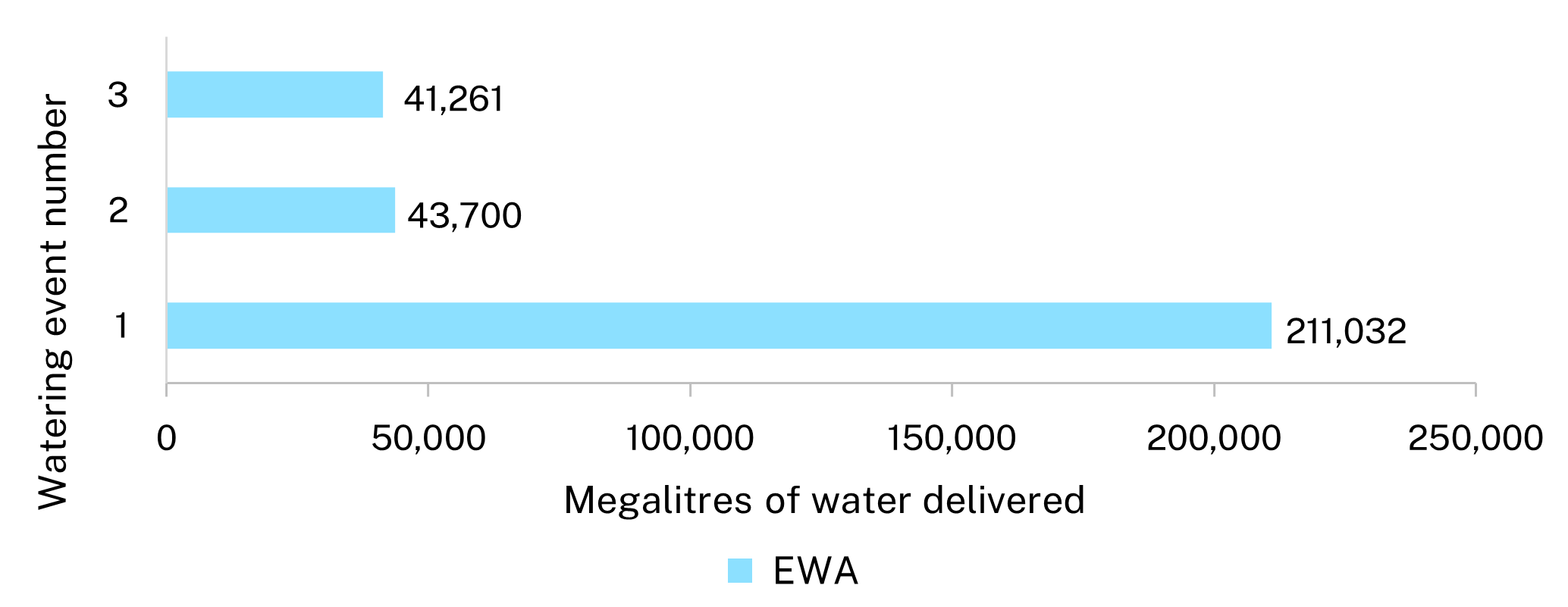
Water delivery to the Snowy catchment in the 2023-24 water year.
Notes: EWA = environmental water allowance accrued under the water sharing plan
| Water event number | Event name | Outcomes | Start date | Finish date |
|---|---|---|---|---|
| 1 | Snowy River | Connectivity | 1 May 2023 | 30 April 2024 |
| 2 | Montane streams | Connectivity | 1 May 2023 | 30 April 2024 |
| 3 | Upper Murrumbidgee | Connectivity | 1 May 2023 | 30 April 2024 |
Flow patterns of environmental water release
These graphs represent the flow patterns of environmental water released into the Snowy River from Jindabyne Dam and the upper Murrumbidgee River from Tantangara Dam.
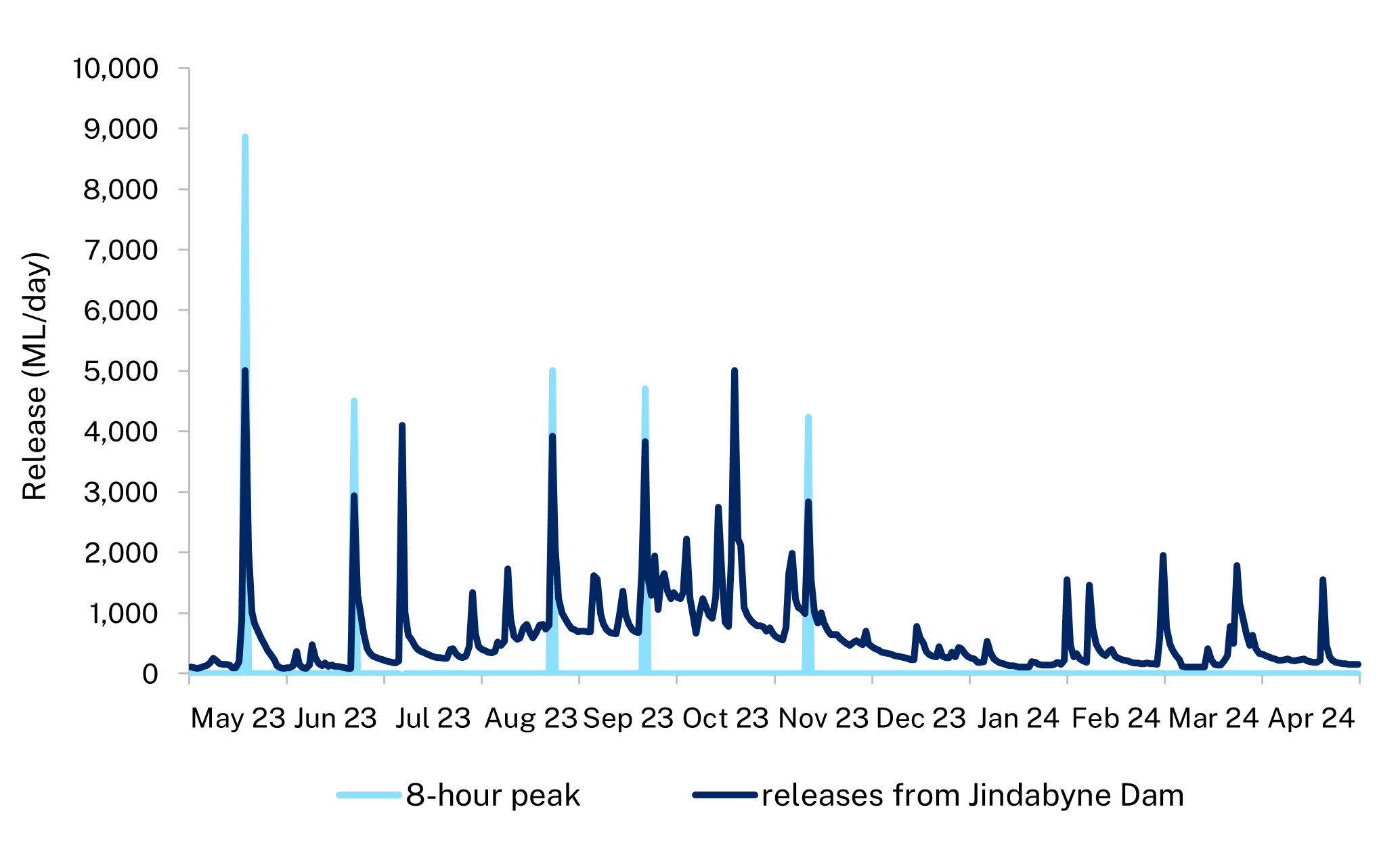
Daily flow pattern for environmental water delivered to the Snowy River from Jindabyne Dam in 2023–24. The pale blue line represents 8-hour peak flow deliveries. Note the dam level was not high enough for the 8-hour peak flow scheduled for 18 October 2023
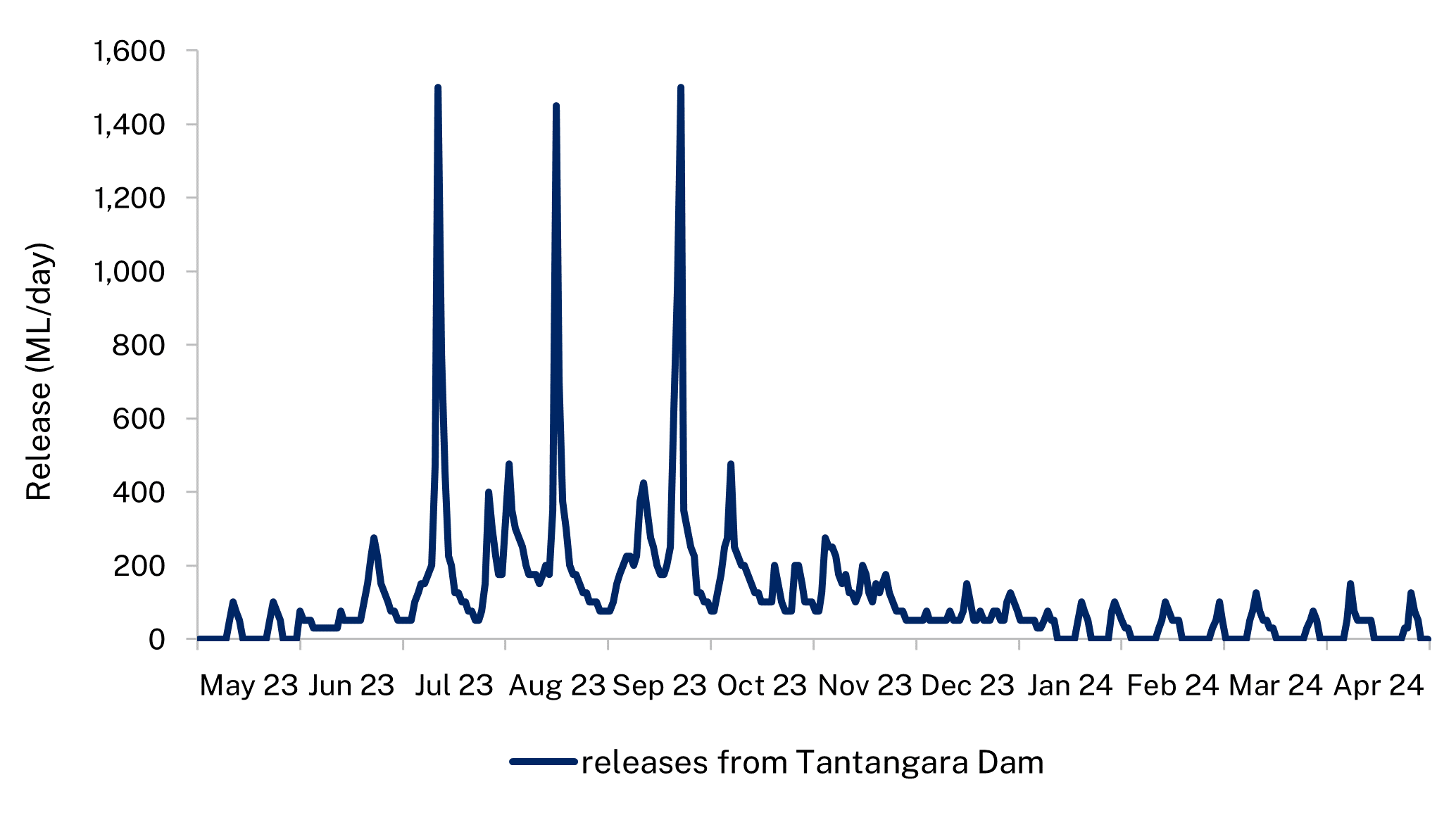
Daily flow pattern for environmental water delivered to the upper Murrumbidgee River from Tantangara Dam in 2023–24.
Against the provided allocations, an under-delivery of 1,030 megalitres was recorded in the Snowy River. This volume will be made up in the 2024–25 allocation. An over delivery of 66 megalitres was recorded in the upper Murrumbidgee, which will be deducted from the 2024–25 allocation.
| River/creek | Target (gigalitres) | Actual (gigalitres) |
|---|---|---|
| Snowy River (Jindabyne) | 212.06 | 211.03 |
| Upper Murrumbidgee (Tantangara) | 41.195 | 41.261 |
| Goodradigbee | 7.0 | 7.6 |
| Middle and Strzelecki creeks | 22.7 | 18.8 |
| Falls Creek | 3.4 | 2.8 |
| Diggers and Tolbar creeks | 18.9 | 14.5 |
Outcomes
In 2023–24, environmental water managers worked with Snowy Hydro and other stakeholders to deliver water for the environment to the Snowy, upper Murrumbidgee, Geehi and Goodradigbee rivers. Environmental flows supported river connectivity to improve river health and provided important habitat for water-dependent native plants and animals, including frogs, platypus and fish.
High flows flushed sediment and cleaned riffles to improve instream habitat.
The high flows played a crucial role in connecting ponds and small wetlands along the Snowy and upper Murrumbidgee rivers. The connection of these habitats supported breeding activities for a diversity of frog species. Water managers conducted frog monitoring and found 9 frog species, including the threatened alpine tree frog.
The alpine tree frog, a subspecies of the broadly distributed whistling tree frog, was found along the upper Murrumbidgee and upper Snowy rivers. This species occurs in alpine and sub-alpine zones or high country in south-eastern New South Wales and Victoria, usually above 1,100 metres and mostly located within Kosciuszko National Park. The species is listed as endangered in New South Wales and vulnerable under Commonwealth legislation.
Case study: opportunistic flushing flow
Flushing flows help mitigate the effects of low flows from river regulation. Low flows from regulation contribute to the constriction of river channels and the buildup of sediment on instream habitat used by fish, frogs and macroinvertebrates.
The cone valve of Jindabyne Dam is designed to release flows up to 5,000 megalitres per day. Releases larger than this volume need to be delivered from the spillway. The spillway can only be operated if water levels in the dam rise above the base of the spillway gates. In many years, this level is not reached. Continuing to build on environmental releases in preceding years to increase variability in the Snowy, a new approach was developed to achieve high flows . The Department of Climate Change, Energy, the Environment and Water and Snowy Hydro cooperated to capitalise on the predicted high storage volumes at the beginning of the 2023–24 water year.
Flushing flows are usually scheduled for October or November, and Snowy Hydro is required to deliver one flushing flow per year. Holding Jindabyne Dam at high levels to achieve a flushing flow may increase the risk of spills. To avoid this risk, dam levels were not held high in 2023–24, but Snowy Hydro agreed to schedule 2 flushing flows, one in May and the other in October 2023. These flows would be delivered if dam levels were high enough.
The first scheduled flow occurred in May 2023 with a peak flow equivalent to 8,860 megalitres/day made over an 8-hour period. This 8-hour flow is designed to enhance wetting of riparian areas, allow greater connectivity for fish movement, maintain and improve the channel profile, and mobilise sediment that has settled on rocky instream habitat.
Dam levels were not high enough to allow a flushing flow in October 2023, so a flow was delivered at the maximum valve capacity of 5,000 megalitres over 24 hours.
The programming and opportunistic water delivery in May 2023 allowed a flushing flow to be provided when it would not have been possible under the usual October–November schedule. This water flow management for the year was also accomplished without the risk of dam spills.
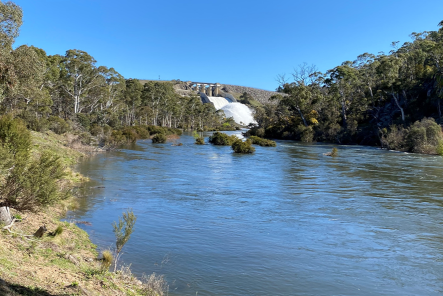
Flushing flow released from Jindabyne Dam into the Snowy River.